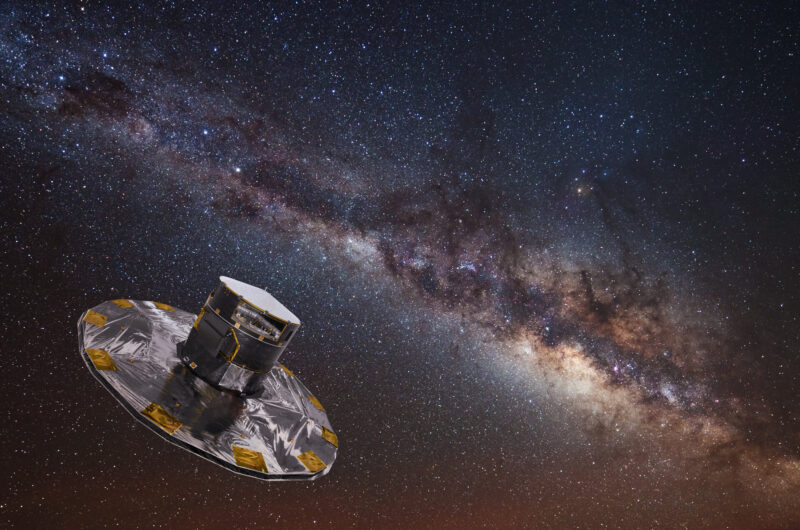EarthSky’s Deborah Byrd created this 1-minute video summary for you on Gaia BH3!
- The most massive stellar black hole in the Milky Way is now Gaia BH3. It has a mass 33 times that of our sun.
- Gaia BH3 is located 2,000 light-years away in the constellation Aquila, making it the 2nd-closest known black hole to Earth.
- The discovery challenges previous theories, suggesting that high-mass black holes may form from metal-poor stars, supported by Gaia’s observation of a metal-poor companion star to Gaia BH3.
EarthSky needs YOUR help to keep going. Your support, comments, photos, suggestions for stories – and your stories on how you use, value and love EarthSky’s content – all make our days bright. Thank you for donating!
Meet Gaia BH3
The European Southern Observatory said on April 16, 2024, that its astronomers have helped confirm the discovery of the most massive stellar black hole yet discovered in our home galaxy, the Milky Way. They call the object Gaia BH3. And it isn’t the Milky Way’s most massive black hole. Instead, Sagittarius A*, the supermassive black hole at the Milky Way’s center, holds that title with some four million times our sun’s mass. Gaia BH3 has only 33 times our sun’s mass. It’s a pipsqueak in contrast to Sagittarius A*. But it’s the most massive black hole known in the Milky Way that formed from the collapse of a single star.
Gaia BH3 is relatively nearby at 2,000 light-years away. It’s the 2nd-closest known black hole to Earth. It’s located in the direction to the constellation Aquila the Eagle, a noticeable constellation in the Northern Hemisphere summer sky. Astronomer Pasquale Panuzzo, of the National Centre for Scientific Research (CNRS) in Paris, led the collaboration that discovered the massive black hole. He commented:
No one was expecting to find a high-mass black hole lurking nearby, undetected so far. This is the kind of discovery you make once in your research life.
The research study, led by Panuzzo, was published on April 16 in the journal Astronomy & Astrophysics.
The amazing Gaia mission
Now for a word of praise about Gaia, the European Space Agency’s astrometry mission, launched in 2013.
Gaia’s job is to scan the sky repeatedly, observing each of its targeted stars many times over. By the time of its 2nd data release in 2018, Gaia had measurements on 1.7 billion stars!
And the insights about our galaxy revealed by Gaia’s measurements have been nothing short of spectacular. For example, we’ve known our sun and all the stars in the Milky Way are moving continuously in great orderly masses around the center of our galaxy. We’ve known that, but we didn’t have many details about how each star moves, until Gaia. How could we? The data for so many stars would be (are) massive. Collecting the data, storing it and analyzing it requires today’s spacecraft and computer technologies. And that’s where Gaia comes in.
You can read many stories about new insights made possible by Gaia here.

How Gaia spied the black hole
Black holes are … black. No light escapes them. So how did Gaia discover our galaxy’s most massive stellar-mass black hole? It was able to do it because the hole imposes a “wobbling” motion on its companion star. In the course of Gaia’s acquiring measurements – and as astronomers analyzed those measurements – the wobble became noticeable to the astronomy world. And then, ESO said:
Data from the European Southern Observatory’s Very Large Telescope (ESO’s VLT) and other ground-based observatories were used to verify the mass of the black hole, putting it at an impressive 33 times that of the sun.
What are stellar-mass black holes?
As so often happens in astronomy, the theory of black holes preceded our discovery of them. The theory arose from the work of Albert Einstein in 1915, and so, throughout the early part of the 20th century, astronomers wondered if black holes did exist, and how we might find objects that emit no light. Astronomers agreed that, if black holes did exist, they probably formed when massive stars ran out of fuel and collapsed.
The first known black hole was seen in X-rays in 1964, in one of the first rocket flights needed to get high enough up that the X-rays weren’t blocked by Earth’s atmosphere. During this flight, astronomers discovered one of the brightest X-ray sources in the sky. Because it was located in the direction of the constellation Cygnus, they named it Cygnus X-1. This object – called Cyg X-1 for short – is now thought to have about 21 times our sun’s mass.
Do metal-poor stars lead to high-mass black holes?
So before Gaia GH3, we didn’t know of any black holes in our Milky Way galaxy with 33 stellar masses. But we knew such massive black holes existed, because they’d been found in other galaxies. But the formation of these black holes provided astronomers with a puzzle. These scientists’ statement explained:
[Astronomers] theorized that they may form from the collapse of stars with very few elements heavier than hydrogen and helium in their chemical composition. These so-called metal-poor stars are thought to lose less mass over their lifetimes and hence have more material left over to produce high-mass black holes after their death.
But evidence directly linking metal-poor stars to high-mass black holes has been lacking until now.
Stars in pairs tend to have similar compositions, meaning that BH3’s companion holds important clues about the star that collapsed to form this exceptional black hole. UVES data showed that the companion was a very metal-poor star, indicating that the star that collapsed to form BH3 was also metal-poor, just as predicted.

Bottom line: Astronomers have discovered the most massive stellar black hole yet discovered in our home galaxy, the Milky Way. They call the object Gaia BH3.
Source: Discovery of a dormant 33 solar-mass black hole in pre-release Gaia astrometry
Via ESO